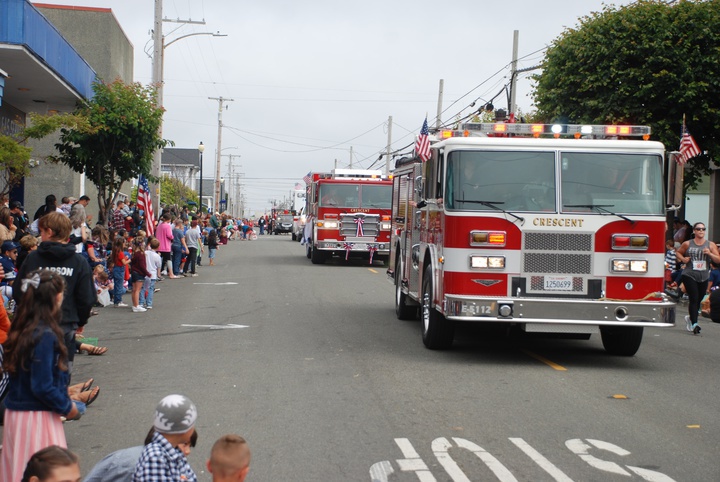Jessica Cejnar / Wednesday, May 19, 2021 @ 11:44 a.m.
Crescent City Councilors Support Fire District Property Tax Assessment

Crescent City Fire & Rescue trucks move down H Street during the 2019 Fourth of July parade. Photo: Jessica Cejnar
Previously:
• Crescent Fire Takes Second Crack at Property Tax Assessment
###
Crescent City Councilors on Monday voted as elected officials and property owners for a second time in support of a tax assessment benefiting the Crescent Fire Protection District.
Though the city received ballots in the mail for two properties it owns within the fire protection district, if voters approve the assessment, Crescent City will be paying $81.40 per parcel for four properties, City Manager Eric Wier told Councilors.
These properties include booster stations at Wonder Stump Road and Railroad Avenue as well as parcels associated with a 1.5 million gallon water storage tank on Amador Street and a 4 million gallon water storage tank on Washington Boulevard.
“This is the second time around for the Crescent Fire Protection District,” Wier told Councilors, pointing out that this is the district’s second attempt to get voters to approve a property tax assessment. “All vacant properties within the Crescent Fire Protection District are not going to be assessed, including city parcels. The four city parcels that will be assessed within the city are two booster stations and two water tanks.”
The Crescent Fire Protection District began sending ballots to its constituents on April 30 in the hopes they will approve a $74 per-parcel assessment to replace an $18 assessment from 2006 that’s sunsetting at the end of the year, according to Chief Bill Gillespie. He noted that the previous attempt last autumn failed by about 23 votes.
If voters approve the assessment, the $74 will be added to a $24 assessment approved in 1987 for a total of about $98 per single-family residential home
The per-parcel assessment fee will be capped at $1,000, Gillespie told the Wild Rivers Outpost in April. That cap will be applied to large commercial complexes as well as residential properties that house multiple units, he told the Outpost.
Property owners have until at the close of a regular Crescent Fire Protection District meeting June 14 to submit their ballots.
On Monday, Gillespie told Councilors that the benefit assessment will help establish a volunteer staffing program at the fire station so firefighters can respond quicker to calls for service. He noted that during the daylight hours on Monday, personnel responded to six to seven calls for service.
Gillespie also brought up a Crescent Fire and Rescue master plan approved in 2019 by both the district and the City Council. He noted that while the master plan mentioned paid captains overseeing a “sleeper crew” of volunteers, it’s a strong guiding document that could be fluid.
The master plan also called for more training and the establishment of a reserve account that could help replace apparatus and equipment, Gillespie said.
“Combined, we’ve responded to a total of 2,000 calls for service — I’m proud of the service we provide — but we can’t do it without support,” he said. “We can’t do it for free. If this doesn’t prevail, if it doesn’t pass, the fire district has about two years, maybe three years at the most, of being able to operate out of the reserve that’s set aside.”
Gillespie noted that Measure S — Crescent City’s 1 percent sales tax measure approved by voters in November — benefits the city. The fire district’s assessment is for the fire district only, though both agencies Crescent City Fire and Rescue.
Measure R — the county’s successful 1 percent sales tax measure — “gives nothing” to the fire protection district, Gillespie said.
During public comment, Del Norte County District 1 Supervisor Darrin Short, who has been a volunteer firefighter for about 30 years, said the $18 assessment from 2006 that’s sunsetting in 2022 was to cover the cost of replacing aging vehicles. That money purchased a water tender, a fire engine and a heavy rescue vehicle, Short said, with little left over.
“The cost of those vehicles almost exactly matched what the ask was back in 2006,” he said. “If you take that into account, Crescent Fire Protection District, who runs approximately 60 percent of the entire call fire department call volume for the entire county has been functionally operating on $24 that was passed back in 1987.”
Short said he brought that up in response to comments on social media criticizing the way the fire district manages its money.
“I joined the department in 1989, a couple years after,” Short said, “I remember Chief Fred Cox saying we ran 35 calls this year (in) 1991-92. Last year, we ran 2,068 calls for service. In my opinion, we have run our department fiscally conservatively and, at this point, we are respectfully requesting the people in the outlying area of Crescent City, who own and improve parcels, allow us to keep operating in the way we hope to serve those people in our district.”
In November 2019, just before the City Council and Fire Protection District Board of Directors approved the master plan, Colette Metz, of PlanWest Partners, said it would cost a total of about $662,000 to implement that plan. Crescent City’s cost would be $307,000 and the Crescent Fire Protection District’s cost would be $355,000, Metz said.
CLICK TO MANAGE